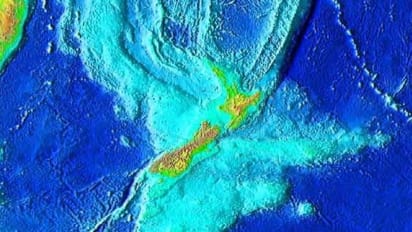Zealandia: 8th Continent Of The Earth - Explained
Beneath New Zealand, there exists a huge mass of land, now lying underneath the ocean. Around 85-79 million years ago, there existed enormous mass of biosphere, comprising of various terrains like volcanos, plains, grandeur mountains covered with lush forests. Before 85-79 billion years ago, the mass land broke off and submerged inside the water due to uninterruptible, shattering movement of 2 huge tectonic pates. This led to the submerge of the terrain inundate in the huge whirlpool of water. GNS Science, a New Zealand research institute, reported two new maps and an interactive website on 22/6/2020, Monday. The maps cover the shape of the ocean floor and Zealandia's continental profile, which collectively help narrate the story of the continent's boundary.
Now, interactive maps reveal new research about the underwater continent where dinosaurs once roamed, and allow the public to virtually explore it the geographic terrains. The maps also help simulate the setting of New Zealand's volcanoes, sedimentary basins, and other geological features, said GNS Science in a news release. Interested geologists around the world can explore the continent from their own homes; the interactive website revealss different types of maps of Zealandia, which users can layer and toggle as they like. For instance, one could locate all the ancient and modern volcanoes on the continent, or see where on the land mass ridges are still spreading.
The concept of a possible continent in this field has been around for some time, and the geophysicist Bruce Luyendyk first coined the term "Zealandia" in 1995. The dedicated analysis of this field, stretching approximately 5 million square kilometers (approximately 1,93 million square miles), has since determined that it is not only a group of continental islands and fragments, but a wide and separate continental crust. How the continent sank The conception of a potential continent in this area has been around for some time, and the denomination "Zealandia" was first coined by geophysicist Bruce Luyendyk in 1995. The dedicated study of this area, stretching about 5 million square kilometers (about 1.93 million square miles), has since determined it is not just a group of continental islands and fragments, but a continental crust astronomically immense and dissever enough to be officially declared a separate continent.
Zealandia used to be a component of Gondwana, the supercontinent that once held many of the continents we ken today, like Africa and South America.
About 85 million years ago, Zealandia split off from Gondwana. The drifting, shifting land mass, about half the size of Australia, was home to dinosaurs and lush rainforest.
What is the Ring of Fire?
Then, millions of years later, the world's tectonic plates - pieces of the Earth's crust commenced reorganizing themselves, in a period of dramatic geological change that withal engendered the Pacific "Ring of Fire", a belt in the Pacific where the world's most active volcanoes are located.
During this time, the Pacific Plate - the world's most astronomically immense tectonic plate - is believed to have sank below the continental crust of Zealandia. This process, called subduction, caused the root of the continent to break off and sink as well, according to the National Science Substratum, a US regime research agency.
About 94% of Zealandia is now submerged submerged - but some components of the continent are still above land, making up Incipient Zealand and other minuscule islands. The apex of Zealandia is Aoraki--Mount Cook at 3,724 meters (12,218 feet).
There is still much unknown about the continent and whether the revelation of Zealandia could transmute historical climate models. As more research emerges, the interactive website and maps will be updated to reflect what we ken, verbally expressed GNS Science.






Super
ReplyDeleteKeep it up
ReplyDeleteSuper
ReplyDelete